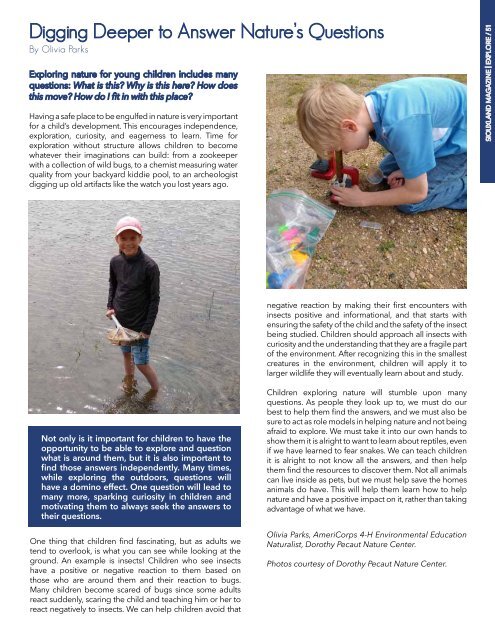Siouxland Magazine - Volume 2 Issue 2
Create successful ePaper yourself
Turn your PDF publications into a flip-book with our unique Google optimized e-Paper software.
Digging Deeper to Answer Nature’s Questions<br />
By Olivia Parks<br />
Exploring nature for young children includes many<br />
questions: What is this? Why is this here? How does<br />
this move? How do I fit in with this place?<br />
Having a safe place to be engulfed in nature is very important<br />
for a child’s development. This encourages independence,<br />
exploration, curiosity, and eagerness to learn. Time for<br />
exploration without structure allows children to become<br />
whatever their imaginations can build: from a zookeeper<br />
with a collection of wild bugs, to a chemist measuring water<br />
quality from your backyard kiddie pool, to an archeologist<br />
digging up old artifacts like the watch you lost years ago.<br />
<strong>Siouxland</strong> <strong>Magazine</strong> | Explore / 51<br />
negative reaction by making their first encounters with<br />
insects positive and informational, and that starts with<br />
ensuring the safety of the child and the safety of the insect<br />
being studied. Children should approach all insects with<br />
curiosity and the understanding that they are a fragile part<br />
of the environment. After recognizing this in the smallest<br />
creatures in the environment, children will apply it to<br />
larger wildlife they will eventually learn about and study.<br />
Not only is it important for children to have the<br />
opportunity to be able to explore and question<br />
what is around them, but it is also important to<br />
find those answers independently. Many times,<br />
while exploring the outdoors, questions will<br />
have a domino effect. One question will lead to<br />
many more, sparking curiosity in children and<br />
motivating them to always seek the answers to<br />
their questions.<br />
One thing that children find fascinating, but as adults we<br />
tend to overlook, is what you can see while looking at the<br />
ground. An example is insects! Children who see insects<br />
have a positive or negative reaction to them based on<br />
those who are around them and their reaction to bugs.<br />
Many children become scared of bugs since some adults<br />
react suddenly, scaring the child and teaching him or her to<br />
react negatively to insects. We can help children avoid that<br />
Children exploring nature will stumble upon many<br />
questions. As people they look up to, we must do our<br />
best to help them find the answers, and we must also be<br />
sure to act as role models in helping nature and not being<br />
afraid to explore. We must take it into our own hands to<br />
show them it is alright to want to learn about reptiles, even<br />
if we have learned to fear snakes. We can teach children<br />
it is alright to not know all the answers, and then help<br />
them find the resources to discover them. Not all animals<br />
can live inside as pets, but we must help save the homes<br />
animals do have. This will help them learn how to help<br />
nature and have a positive impact on it, rather than taking<br />
advantage of what we have.<br />
Olivia Parks, AmeriCorps 4-H Environmental Education<br />
Naturalist, Dorothy Pecaut Nature Center.<br />
Photos courtesy of Dorothy Pecaut Nature Center.


















